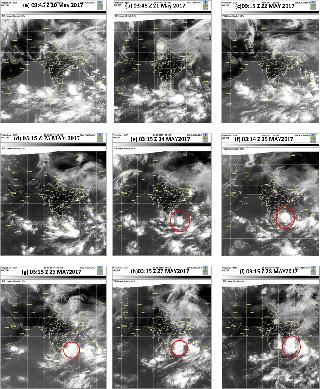当前位置:
X-MOL 学术
›
Q. J. R. Meteorol. Soc.
›
论文详情
Our official English website, www.x-mol.net, welcomes your feedback! (Note: you will need to create a separate account there.)
Genesis of severe cyclonic storm Mora in the presence of tropical waves over the North Indian Ocean
Quarterly Journal of the Royal Meteorological Society ( IF 8.9 ) Pub Date : 2021-06-16 , DOI: 10.1002/qj.4113 R. Emmanuel 1, 2 , Medha Deshpande 1, 2 , G. Mano Kranthi 1, 2 , S.T. Ingle 2
Quarterly Journal of the Royal Meteorological Society ( IF 8.9 ) Pub Date : 2021-06-16 , DOI: 10.1002/qj.4113 R. Emmanuel 1, 2 , Medha Deshpande 1, 2 , G. Mano Kranthi 1, 2 , S.T. Ingle 2
Affiliation

|
Tropical cyclone (TC) genesis is still a crucial mysterious problem in tropical meteorology. Over the North Indian Ocean (NIO), TC Mora genesis commenced as a depression on May 28, 2017. Kalpana-IR satellite images indicate a disturbance that developed as a depression within Intertropical Convergence Zone (ITCZ). Tropical Rainfall Measuring Mission (TRMM) rainfall shows the organization of convection that started with clustering of clouds on May 24; thereafter, cloud patches remained intact and became a depression on May 28. During the pre-genesis period (May 20–28), the Madden–Julian oscillation (MJO) was in phase 2 with amplitude greater than 1 and equatorial Rossby (ER) wave was also active over the Indian Basin. These waves facilitated intense convection through the supply of mid-level moisture and low-level vorticity required for the genesis. The presence of ER wave resulted in the formation of circulation at 850 hPa over the equatorial region. From May 22 to 23, the existence of a quasiclosed circulation (QCC) region within ER wave indicates a continuous buildup of moisture and vorticity, separating the region of moist and dry air. Later, the QCC became self-sustained and evolved into a depression on May 28. The streamline overturning point is the inflection point (IP), and the approximate circulation center is the stagnant point (SP). The coexistence of IP and SP along with the minimum stream function and maximum column integrated total precipitable water (TPW) confirms the potential area of genesis. This criterion is applied to track the seeding of vorticity as the preferred genesis location, 5 days before genesis. These locations match well with the best track data locations provided by the India Meteorological Department after May 28. Processes within the QCC are also studied following the QCC during the formation of the depression.
中文翻译:

在北印度洋上空存在热带波浪的情况下严重气旋风暴莫拉的起源
热带气旋(TC)的成因仍然是热带气象学中一个至关重要的神秘问题。在北印度洋 (NIO) 上空,TC Mora 起源于 2017 年 5 月 28 日以低气压的形式开始。 Kalpana-IR 卫星图像显示在热带辐合带 (ITCZ) 内发展为低气压的扰动。热带降雨测量任务 (TRMM) 降雨显示了从 5 月 24 日云团开始的对流组织;此后,云块保持完整,并于 5 月 28 日变为低气压。 在创生前期(5 月 20-28 日),马登-朱利安振荡 (MJO) 处于振幅大于 1 的阶段 2 和赤道罗斯比 (ER)波也活跃在印度盆地上空。这些波浪通过提供成因所需的中层水分和低层涡度促进了强烈对流。ER 波的存在导致赤道地区在 850 hPa 形成环流。5 月 22 日至 23 日,ER 波内存在准封闭环流 (QCC) 区域,表明湿气和涡量不断增加,将干湿空气区分开。后来QCC自给自足,于5月28日演变成洼地。流线翻转点为拐点(IP),近似环流中心为停滞点(SP)。IP 和 SP 以及最小流函数和最大柱综合总可降水量 (TPW) 的共存证实了潜在的成因区域。该标准用于在起源前 5 天跟踪作为首选起源位置的涡度的播种。
更新日期:2021-08-04
中文翻译:

在北印度洋上空存在热带波浪的情况下严重气旋风暴莫拉的起源
热带气旋(TC)的成因仍然是热带气象学中一个至关重要的神秘问题。在北印度洋 (NIO) 上空,TC Mora 起源于 2017 年 5 月 28 日以低气压的形式开始。 Kalpana-IR 卫星图像显示在热带辐合带 (ITCZ) 内发展为低气压的扰动。热带降雨测量任务 (TRMM) 降雨显示了从 5 月 24 日云团开始的对流组织;此后,云块保持完整,并于 5 月 28 日变为低气压。 在创生前期(5 月 20-28 日),马登-朱利安振荡 (MJO) 处于振幅大于 1 的阶段 2 和赤道罗斯比 (ER)波也活跃在印度盆地上空。这些波浪通过提供成因所需的中层水分和低层涡度促进了强烈对流。ER 波的存在导致赤道地区在 850 hPa 形成环流。5 月 22 日至 23 日,ER 波内存在准封闭环流 (QCC) 区域,表明湿气和涡量不断增加,将干湿空气区分开。后来QCC自给自足,于5月28日演变成洼地。流线翻转点为拐点(IP),近似环流中心为停滞点(SP)。IP 和 SP 以及最小流函数和最大柱综合总可降水量 (TPW) 的共存证实了潜在的成因区域。该标准用于在起源前 5 天跟踪作为首选起源位置的涡度的播种。



























 京公网安备 11010802027423号
京公网安备 11010802027423号